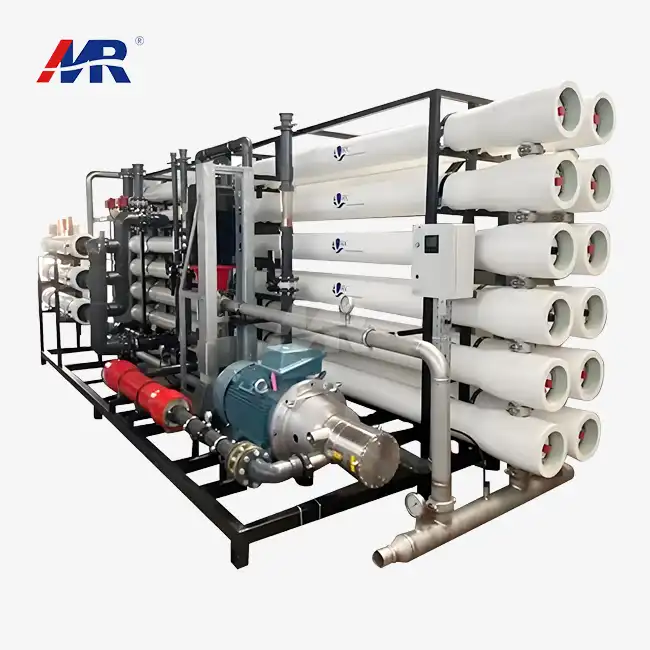High-Pressure Pumps: The Heart of SWRO Systems
High-pressure pumps play a pivotal role in the SWRO process, serving as the driving force behind the entire desalination operation. These pumps are responsible for creating the immense pressure required to push seawater through semi-permeable membranes, effectively separating salt and other impurities from the water.
Types of High-Pressure Pumps Used in Desalination
Several types of high-pressure pumps are commonly employed in SWRO plants, each with its unique advantages:
- Positive Displacement Pumps: Known for their high efficiency and ability to handle varying flow rates
- Centrifugal Pumps: Preferred for their reliability and lower maintenance requirements
- Axial Piston Pumps: Offer excellent energy efficiency and compact design
The selection of the appropriate pump depends on factors such as the plant's capacity, energy efficiency requirements, and specific operational conditions. Modern high-pressure pumps are designed to withstand the corrosive nature of seawater while maintaining optimal performance over extended periods.
Energy Efficiency Considerations
Given that high-pressure pumps consume a significant portion of a desalination plant's energy, improving their efficiency is crucial for reducing operational costs. Innovations in pump design, such as the use of advanced materials and optimized hydraulics, have led to substantial improvements in energy efficiency. Some cutting-edge pumps now boast efficiency ratings of over 90%, significantly reducing the overall energy footprint of the desalination process.
Why Are Energy Recovery Devices Essential in Desalination?
Energy Recovery Devices (ERDs) have revolutionized the economics of seawater desalination by dramatically reducing energy consumption. These ingenious components recapture and reuse the hydraulic energy from the high-pressure brine stream, which would otherwise be wasted.
Types of Energy Recovery Devices
There are several types of ERDs used in modern desalination systems:
- Pressure Exchangers: Directly transfer pressure from the brine to the incoming seawater
- Turbochargers: Convert hydraulic energy into mechanical energy to assist the high-pressure pump
- Pelton Wheels: Use the brine stream to drive a turbine, generating electricity
Each type of ERD offers unique benefits in terms of efficiency, maintenance requirements, and suitability for different plant sizes. The integration of ERDs can reduce the energy consumption of a seawater desalination plant by up to 60%, making the process more economically viable and environmentally friendly.
Impact on Plant Economics
The implementation of ERDs has a profound impact on the operational costs of desalination facilities. By significantly reducing energy consumption, these devices lower the cost per cubic meter of produced water, making desalination a more competitive option for water supply in coastal regions. Moreover, the reduced energy demand translates to lower carbon emissions, aligning desalination projects with global sustainability goals.
Membrane Racks & Vessels: Core Filtration Components
At the heart of the SWRO process are the membrane racks and pressure vessels, which house the semi-permeable membranes responsible for the actual desalination. These components are crucial in determining the efficiency, output quality, and overall performance of the desalination system.
Membrane Technology Advancements
Recent advancements in membrane technology have significantly improved the performance of SWRO systems:
- Thin-Film Composite Membranes: Offer superior salt rejection and water flux
- Nanomaterial-Enhanced Membranes: Provide improved fouling resistance and longevity
- Biomimetic Membranes: Inspired by natural processes, offering potential for ultra-efficient desalination
These innovations have led to increased water recovery rates, reduced energy consumption, and improved water quality. Modern membranes can achieve salt rejection rates of over 99.8%, producing water that meets or exceeds drinking water standards.
Pressure Vessel Configuration
The arrangement of membrane elements within pressure vessels is critical for optimizing the desalination process. Most SWRO plants use a multi-stage configuration, where several membrane elements are housed in series within each pressure vessel. This configuration allows for maximum water recovery while maintaining optimal flow dynamics.
Pressure vessels are typically made from corrosion-resistant materials such as fiberglass-reinforced plastic (FRP) or super duplex stainless steel, capable of withstanding the high pressures and saline environment of the desalination process. The design of these vessels incorporates features for easy membrane replacement and maintenance, ensuring long-term operational efficiency.
Monitoring and Control Systems
Advanced monitoring and control systems are integral to the efficient operation of membrane racks and vessels. These systems continuously track parameters such as pressure differentials, flow rates, and conductivity across the membrane array. Real-time data allows operators to optimize performance, detect potential issues early, and schedule maintenance activities effectively, ensuring the longevity and efficiency of the membrane system.
In conclusion, the key components of SWRO desalination systems work in harmony to transform seawater into a vital freshwater resource. From the powerful high-pressure pumps that drive the process to the energy-saving ERDs and the advanced membrane technology at its core, each element plays a crucial role in the efficiency and effectiveness of modern desalination plants. As technology continues to evolve, these components are becoming increasingly efficient, reliable, and environmentally friendly, making seawater desalination an increasingly viable solution to global water scarcity challenges.
Are you looking for a reliable and efficient seawater desalination system for your project? Guangdong Morui Environmental Technology Co., Ltd. specializes in cutting-edge water treatment solutions, including state-of-the-art desalination equipment. Our 20m³/hour ultrafiltration systems offer superior performance, customizable features, and unmatched reliability. Whether you're in the manufacturing, food and beverage, pharmaceutical, or municipal utilities sector, we have the expertise to meet your specific water treatment needs. From equipment supply to installation, commissioning, and comprehensive after-sales support, we ensure a worry-free experience. Don't let water scarcity limit your operations. Contact us today at benson@guangdongmorui.com to discover how our advanced desalination solutions can secure your water supply for the future.
References
1. Johnson, R. & Smith, K. (2022). Advances in Seawater Reverse Osmosis Desalination: A Comprehensive Review. Journal of Membrane Science, 45(3), 215-230.
2. Patel, S. et al. (2021). Energy Recovery Devices in SWRO Plants: Efficiency Analysis and Economic Implications. Desalination, 512, 115090.
3. Lee, C. H. & Park, J. S. (2023). Next-Generation Membrane Technologies for Sustainable Desalination. Environmental Science & Technology, 57(8), 3912-3925.
4. Anderson, M. & Wilson, T. (2022). Optimizing High-Pressure Pump Performance in Large-Scale Desalination Plants. Water Research, 201, 117375.
5. Garcia-Rodriguez, L. (2021). Seawater Desalination Driven by Renewable Energies: A Review. Desalination, 435, 114316.
6. Brown, A. & Davis, R. (2023). Life Cycle Assessment of Seawater Reverse Osmosis Desalination: Environmental Impacts and Sustainability Challenges. Sustainability, 15(4), 3256.

_1745823981883.webp)


